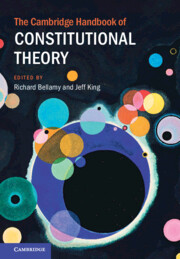Book contents
- The Cambridge Handbook of Constitutional Theory
- The Cambridge Handbook of Constitutional Theory
- Copyright page
- Contents
- Figures
- Contributors
- Frontispiece
- Preface and Acknowledgements
- 1 Introduction
- Part I Values
- 2 Human Dignity
- 3 Rights
- 4 Equality
- 5 Liberty
- 6 Well-Being
- 7 Self-Government
- 8 Justice
- 9 Recognition
- Part II Modalities
- Part III Institutions
- Part IV Challenges for Constitutional Democracy
- Bibliography
- Index
- References
4 - Equality
from Part I - Values
Published online by Cambridge University Press: 27 March 2025
- The Cambridge Handbook of Constitutional Theory
- The Cambridge Handbook of Constitutional Theory
- Copyright page
- Contents
- Figures
- Contributors
- Frontispiece
- Preface and Acknowledgements
- 1 Introduction
- Part I Values
- 2 Human Dignity
- 3 Rights
- 4 Equality
- 5 Liberty
- 6 Well-Being
- 7 Self-Government
- 8 Justice
- 9 Recognition
- Part II Modalities
- Part III Institutions
- Part IV Challenges for Constitutional Democracy
- Bibliography
- Index
- References
Summary
What does it mean to treat people as equals when the legacies of feudalism, religious persecution, authoritarian, paternalistic and oligarchic government have shaped the landscape within which we must construct something better? This question has come to dominate much constitutional practice as well as philosophical inquiry in the past 50 years. The combination of Second Wave Feminism with the continuing struggle for racial equality in the 1970s brought into sharp relief the variety of ways in which people can be treated unequally, while respecting the formalities of constitutional government. In the first part of this chapter, I focus on efforts to reframe the theory and practice of constitutional equality in light of demands for sexual and racial equality. I then show that analytic philosophy has also come to recognise the various non-reducible dimensions of equality in ways that reinforce the claims of critical legal theory, even as philosophers highlight their disconcerting consequences. If equality has multiple irreducible dimensions, conflicts between the legitimate demands of equality are unavoidable features of law and politics, even in the best possible world, and are likely to be particularly painful when set against a background of historical injustice. The chapter concludes with the challenges to democratic constitutionalism, and the scope for constructive responses to those challenges, which the rapprochement between critical and analytic thinking on equality suggests.
Keywords
- Type
- Chapter
- Information
- The Cambridge Handbook of Constitutional Theory , pp. 56 - 70Publisher: Cambridge University PressPrint publication year: 2025

